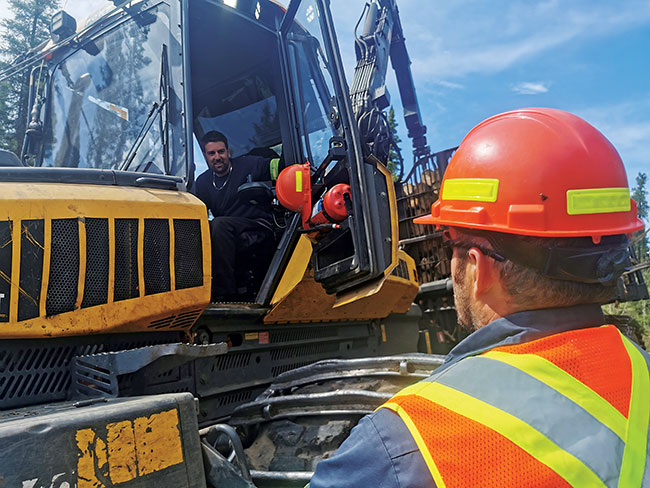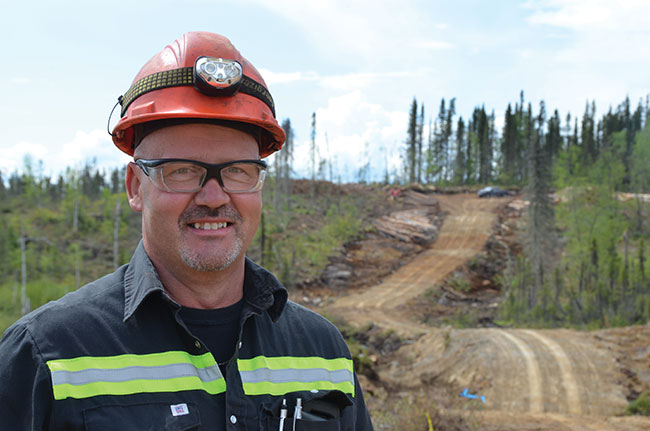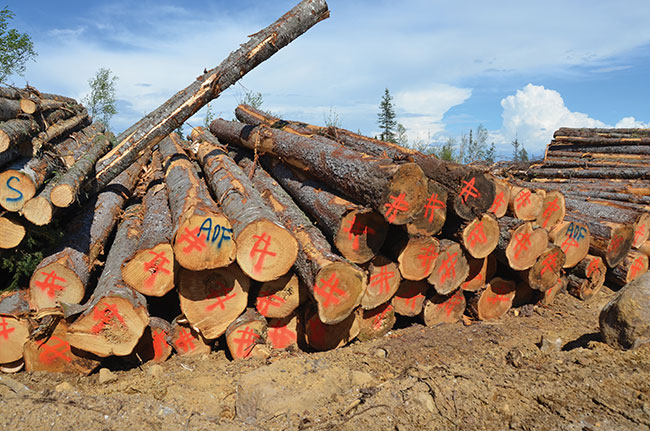
Features
Harvesting
Logging Profiles
Quebec community forest brings local economic and environmental benefits
December 9, 2021 By Guillaume Roy, translated by Peter Diekmeyer
 Michel Bouchard, AGIR’s general manager, talks with one of the operators in the field. Photos by Guillaume Roy.
Michel Bouchard, AGIR’s general manager, talks with one of the operators in the field. Photos by Guillaume Roy. In northern Lac-Saint-Jean, Que., a community forestry model is generating significant income for small municipalities while promoting social acceptance of the industry.
This social economy model is spurring local economic development. Last year, the community forest generated $418,113 worth of investments in 50 community projects. The amount was redistributed between 11 local development corporations, which each received between $16,000 and $107,000.
Those are substantial sums for small municipalities, some of which have barely a few hundred inhabitants, says Marc Laprise, president of l’Agence de gestion intégrée des ressources (AGIR) (Integrated Resource Management Agency). For example, the funds have been used to provide food aid, invest in a play centre, a municipal library, and a climbing gym, and for a youth physical training course.

André Fortin, owner of Forestiers AD Fortin, appreciates the quality of life he has working for AGIR, because he can sleep at home every night.
This community forest model, through which the private forestry contractors partner with the municipalities, has become a source of local pride. “People often see the negative side of forestry, which does not always get good press,” says Laprise, one of the concept’s initiators. “For us, forests are a resource managed sustainably, while being a good source of income.”
The idea of managing the forest differently originated in the 1990s, when the CLD Maria-Chapdelaine (a local development commission) launched consultations to revitalize local communities, says Laprise. “We proposed creating local corporations to generate more income from forests for the surrounding municipalities.”
Corporations were created in eight municipalities, who began negotiations with forest industry players such as Alliance Forest Products to do the forestry operations close to the communities.
“We offered a winning partnership that fostered local control of inhabited forest land,” says Laprise, referring to the public forest lands that surround many municipalities. “Closer hands-on management minimizes conflicts with citizens and enables us to generate income to invest in community projects.”
The local forest corporations obtained an initial logging contract of about 83,000 cubic metres, which had to be renewed each year. Since then, numerous companies have allowed the municipal corporations to manage the harvest on territories located next to intra-municipal public lands under a territorial management agreement managed by the municipalities.
Pierre Cormier, vice-president of forestry operations at Resolute Forest Products, which was in the front row when the system was first put in place, says the model is a win-win.
“It facilitates social acceptability while generating increased benefits for communities,” he notes.
“The forestry industry has provided us excellent business opportunities,” says Michel Bouchard, AGIR’s general manager. “We run the organization like a private company. But instead of paying dividends to shareholders, we pay social contributions locally.”

The quality of the wood is better in nearby forests, says André Fortin. Thus, operations are profitable even if the harvesting areas are smaller.
Over time, the informal agreement with the industry improved so that AGIR, which acts as a general contractor on the forest sites, now harvests more than 190,000 cubic metres per year. Last year, AGIR oversaw 14 harvesting contracts with Resolute Forest Products, one with Remabec and two with Norbord, including one for harvesting and another for road building.
According to Bouchard, an openness among Quebec civil servants facilitated the implementation of this unique community forest model. He believes since forests are harvested and managed according to the needs of the environment and different users, social acceptability is much greater.
“When people have questions, they ask them directly to the representatives on the boards of the local corporations,” adds Laprise, who has been AGIR’s president since 2008. “This gives them a way to make their concerns known.”
Three years ago, AGIR opened its membership to include four new municipal corporations to maximize the economic spinoffs in the area. In total, 12 corporations are administered locally by more than 85 volunteers. Allowable cuts are harvested and the wood is delivered to the mills, but the benefits in the communities are much greater.
Smaller quality lots
Instead of focusing on large logging areas, AGIR plans harvests in small areas while taking into account other land users. The approach requires forestry contractors hired by AGIR to move their machinery more often, which means extra costs, but there are benefits as well.
“The logs are bigger here, which enables us to run profitable operations,” says André Fortin, owner of Forestiers AD Fortin. André says he appreciates the quality of life fostered by local operations because he gets to sleep at home every night, instead of near logging areas.
William Fortin, 24, a harvester operator, also appreciates being close to home. “I didn’t want to go logging deep in the woods,” he says. “I like it right here.”
Being in close proximity to managers from AGIR also facilitates quick decision making for the contractors and thus efficiency, notes André.
In his operations for AGIR, he uses Tigercat 845 and 855 harvesters fitted with Ponsse H7 heads. During CFI’s visit, the company was using a Ponsse Elephant forwarder, which was due to be replaced by a Ponsse Elephant King. This forwarder was repatriated from Forestiers AD Fortin’s operations further north with Resolute Forest Products, as the company had opted for a larger model, a Tigercat 1085 with a 24-tonne basket.
At the beginning of July, Forestiers AD Fortin was logging an area 10 kilometres north of Saint-Edmond-Les-Plaines, Que., which was ravaged by the spruce budworm.
“We harvest under a special ministerial plan,” says Bouchard. “Instead of harvesting a single large cutting area, we harvest in patches. This enables us to better distribute cuts and moderate harvest intensity, while leaving residual forest, which improves the landscape.”
AGIR is testing a new market in this area – harvesting black spruce tops for Labrador Production, which produces essential oils.
AGIR also offers technical and professional services to the Opitciwan sawmill, the municipality of Domain-du-Roy, and other organizations, and carries out urban forestry, agroforestry, agro-environment, environmental management and biodiversity projects as well as recreational tourism development.
Print this page